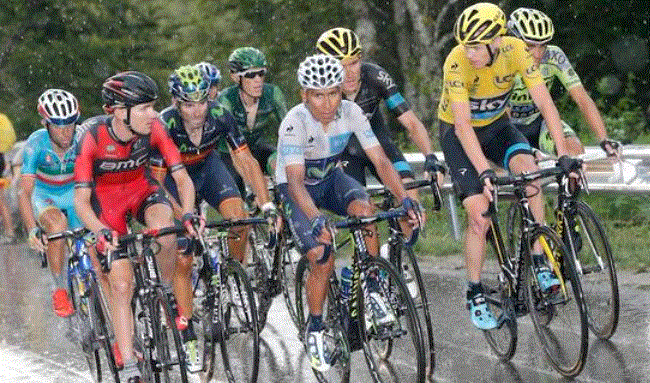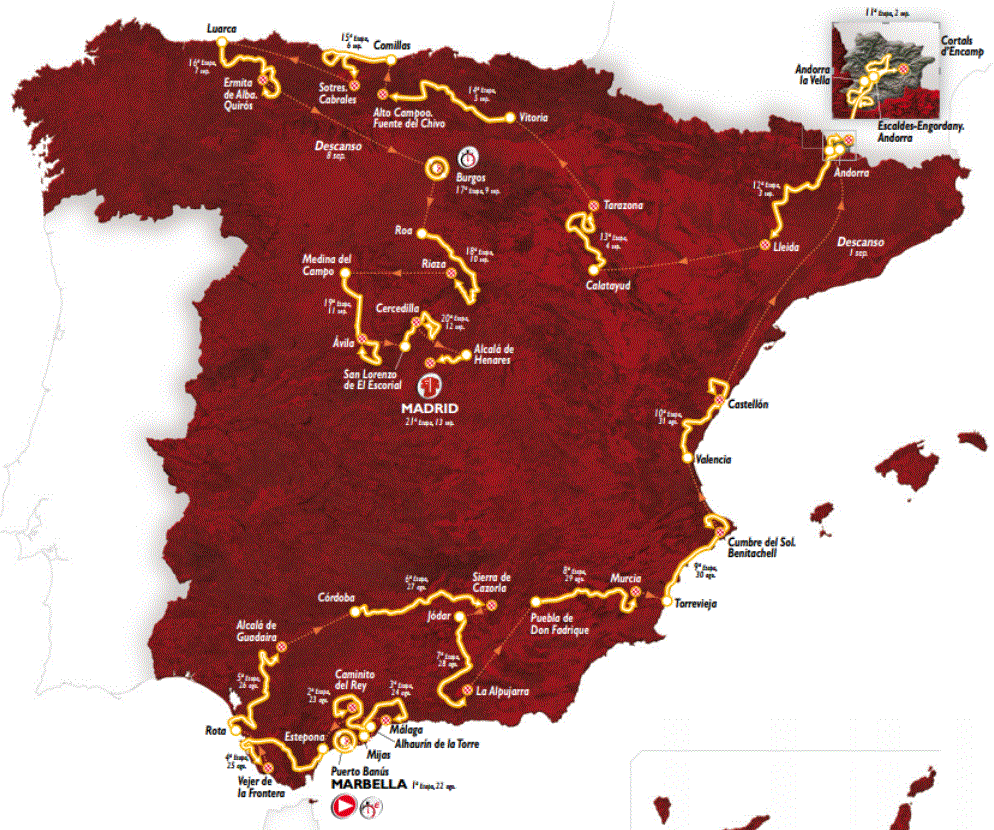- Details
- Published on Monday, 10 August 2015 23:13
Vuelta a España Preview
A look at the route and favourites for the 2015 Vuelta a España
The 2015 Vuelta a España kicks off in Portabanus on Saturday the 22nd August with a 7.4km Team Time Trial and finishes on Sunday the 13th September with a stage for the sprinters in Madrid. It is the 70th running of the race and will cover 3,374.4kms over the three weeks on a route that takes them all around Spain and even in to Andorra for a day.
It’s an unusual route that the organisers have chosen this year, in that the first week is particularly hard, with four summit finishes and all nine mountain-top finishes coming in the first two weeks of racing. Rather incredibly for a Grand Tour, not one of the nine summit finishes have been used before in the Vuelta, so it should lead to some dramatic and unpredictable racing in the first two weeks. Check out the route video below which is pretty cool.
And then at the end of the race, just in case some of the climbers have managed to stay pretty close to each other, there’s a 38km individual time trial on stage 17, with just four stages to go once it’s done. As of the time of writing, Chris Froome hasn’t confirmed yet that he's going to be doing the Vuelta, but the organisers promised him a flat time trial after he was narrowly beaten in 2014 by Alberto Contador, and after delivering on their promise, it would be rude of him not to turn up now! Just today he was on the preliminary list of fourteen riders that Sky submitted, of which nine riders will make the final cut. Of course, it doesn’t mean he will definitely ride, but the fact he is on the list as the number one rider makes it highly likely now. (He has now confirmed he is riding the Vuelta in a tweet! Great!)
If he does turn up, then we are in for a real treat – Nairo Quintana, Vincenzo Nibali and Tejay Van Garderen are scheduled to renew rivalries, each with a point to prove. Alejandro Valverde will also be battling for victory after playing second fiddle to Nairo in the Tour, and with the likes of Fabio Aru, Mikel Landa, Dan Martin, Joaquim Rodriguez, Domenico Pozzovivo and Rafal Majka, it should make for a fantastic race.
Froome would be going for the Tour-Vuelta double, a very rare achievement indeed, something only achieved by Jacques Anquetil in 1963 and Bernard Hinault in 1978. We are of course missing Alberto Contador though, who has decided to call an earrly end to his season at the end of the Tour. Besides Contador though we’ll have the top three from the Tour starting with Froome, Quintana and Valverde, with the unlucky TVG, who was sitting in 2nd place before getting ill, getting a shot at redemption.
The Route
The race starts right down in the south of Spain, so could make for some incredibly hot stages in the opening days as the temperatures are sure to be well in to the thirties every day. After the initial TTT over 7.4kms, the first road stage (stage 2) is flat for most of the day, but already on just the first road stage it sees them hit their first summit finish of the race with the climb up the Alto de la Mesa. Stage 3 to Malaga should be one for the sprinters, Stage 4 and 5 should also be ones for the sprinters, but feature uphill finishes so we mightn’t see the pure sprinters, but the punchy stronger types come to the fore.
Stage 6 sees them head in to the hills with the uphill summit finish to Sierra de Cazorla, and that’s followed by the first real chance for the GC men to test each other and start to put some time gaps between them and the rest with the 1st Cat climb to the finish at La Alpujarra on Stage 7. It is almost 20kms long and goes in two waves, we’ll surely see the mountain goats kick on to try to punish anyone struggling with their climbing legs.
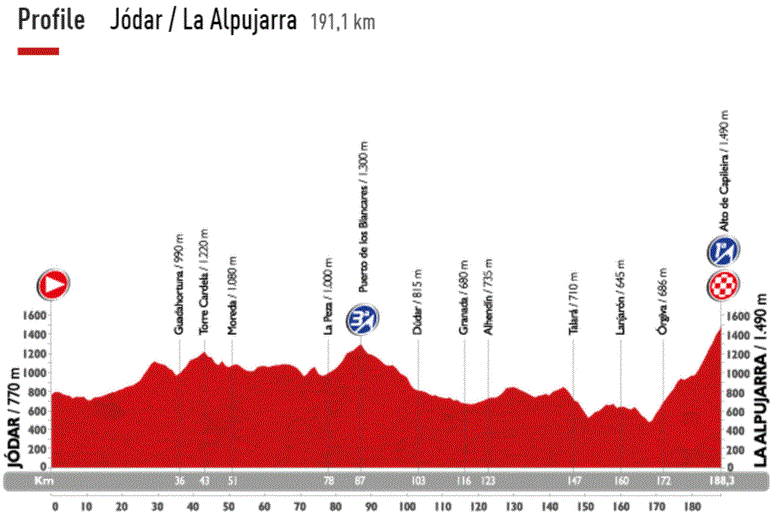
Stage 8 sees them descend down from the hills again and it ends with a flat finish at Murcia, but not before they have to get over the short and nasty Alto de la Cresta de Gallo, twice in 20kms, the last time with just 12kms to go. It might shake out some of the sprinters, it could give late attackers a chance of winning.
Stage 9 is dead flat for 124kms before they arrive at the Alto Cumbre del Sol which they climb twice in the last 40kms, the second time up going higher and harder than the first. Stage 10 should be a day for the sprinters, that is if they can get over the Cat 2 climb of the Alto del Desierto de Las Palmas, which they crest with less than 24kms to go. Stage 11 comes after the rest day and it is sure to be a real leg-breaker – six climbs, over 5,000m in climbing, all spent in the principality of Andorra. The summit finish to Alto Els Cortals is a Cat 1 brute that will separate the wheat from the chaff after a very hard day in the saddle. Add in the possibility of unpredictable weather conditions in Andorra and it could be an epic stage.
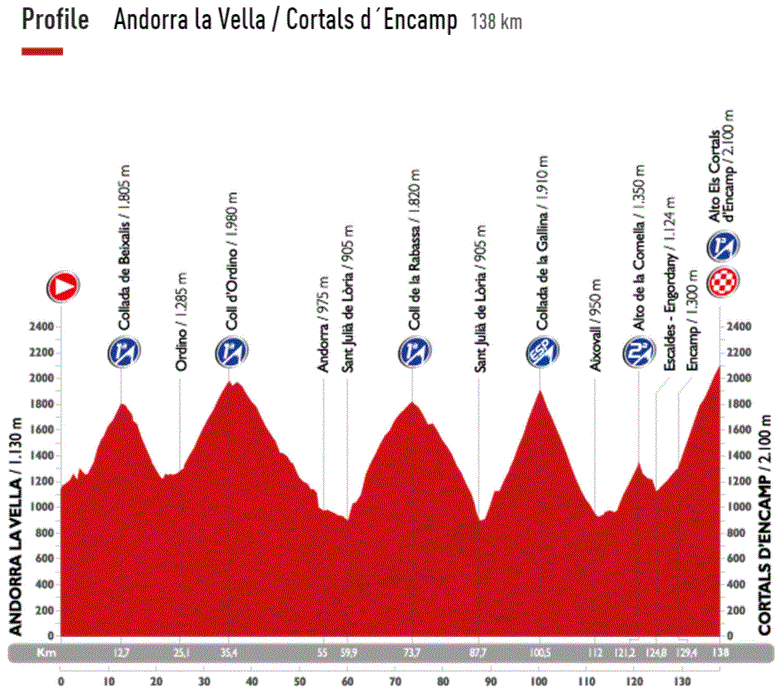
Stage 12 is a 173km jaunt to Lleida which should end in a sprint, Stage 13 is just 4kms longer and is a bit lumpier, meaning it could end in a sprint, or possibly the break could make it this day. Stage 14 starts flat for 100kms, then goes over a Cat 3, drops down to the valley and climbs back up a Cat 1 climb again and after 30 more flat kilometres suddenly kicks up to another summit finish at Alto Campoo.
Stage 15 is a similar stage, 100kms or so of flat, a Cat 2, a Cat 3 and then a ramp up to yet another summit finish at Alto de Sotres. Stage 16 is a shark’s–tooth profile stage with seven climbs in 185kms, finishing with a Cat 2, a Cat 1 and an Esp climb inside the last 35kms. This could be the last time for the climbers to really create a big buffer ahead of the TT the next day.
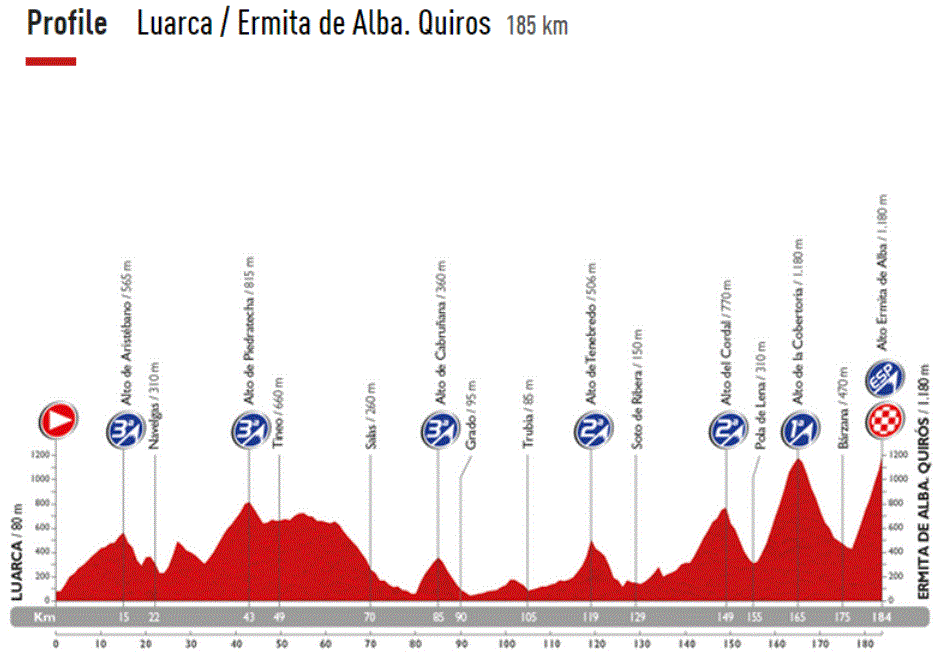
Stage 17’s TT is more or less flat but long at 38.7kms, one for the pure power specialists like Tom Dumoulin or Fabian Cancellara, but it could well shape the final top 10 if some riders are still close together. Stage 18 could see a break make it, the day after the TT when a lot of the GC men and teams will be tired. 204kms long, with a rolling profile that includes a Cat 1 climb just 12.6kms from the finish in Riaza. Stage 19 could again see a break make it as desperate teams without a win send men up the road in hope. We could see a reduced group sprint though with a Cat 2 climb just 20kms from the finish.
The penultimate stage on live Saturday afternoon TV could be one last treat, one last opportunity for a GC re-shuffle with 4 Cat 1 climbs, including the double ascension of the Puerto de la Morcuera. Stage 21 sees the final procession in to Madrid and the likely sprint finish.
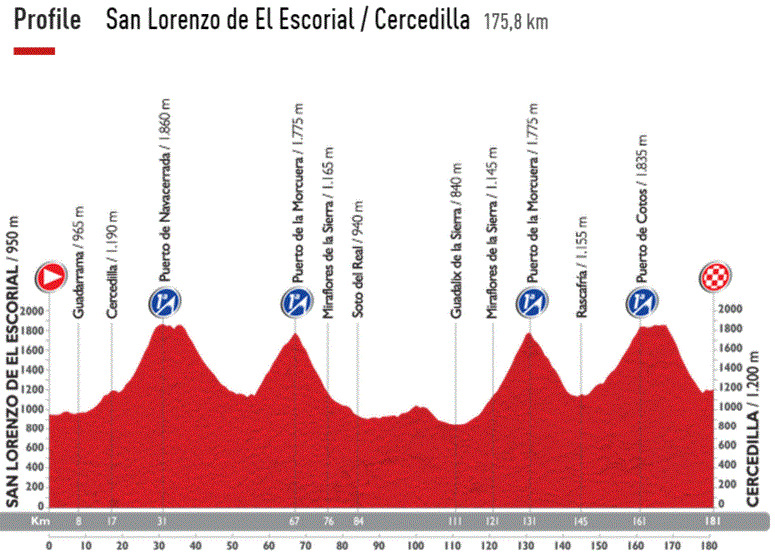
It’s definitely a course that favours the climbers and the punchier, lighter guys at that. You can see why the likes of Quintana, Valverde and Martin want to do it, and Chris Froome will be pretty happy with the climbing, a TTT and a long, flat ITT. It will be interesting to see how Nibali will go on this course as he will need lots of time ahead of the TT, but Tejay Van Garderen is probably the opposite, he will just need to try to hang in there and stay close enough to really go for it in the TT, he could put huge time in to some of the climbers over 38kms.
The Sprinters have some, but not a lot of stages to get stuck in to and there are plenty of opportunities for the brave breakaway riders. It is a difficult route that will see a real champion emerge at the end of its three weeks and nearly 3,400kms.
A full preview of all the favourites, jerseys and special markets will be available in the days before the Vuelta starts and will be available to subscribers only. Click here to subscribe now and save 10% before midnight on August 19th.



